

Almost Nothing Left at First & Denny! - Queen Anne Historical Society. This odd-shaped intersection separating Queen Anne’s Uptown from Belltown is uniquely historic.
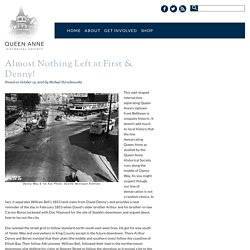
It doesn’t add much to local history that the line demarcating Queen Anne as studied by the Queen Anne Historical Society runs along the middle of Denny Way. As you might suspect though, our line of demarcation is not a random choice. In fact, it separates William Bell’s 1853 land claim from David Denny’s and provides a neat reminder of the day in February 1853 when David’s older brother Arthur and his brother-in-law Carson Boren jockeyed with Doc Maynard for the site of Seattle’s downtown and argued about how to lay out the city. Doc wanted the street grid to follow standard north-south east-west lines. He got his way south of Yesler Way and everywhere in King County except in the future downtown.
Denny Way is also odd name for a busy street. Brief History of Seattle - CityArchives. Home. Sir20105254 chap1. The Metropolitan Frontier: Cities in the Modern American West - Carl Abbott - Google Books. Eagleton Institute of Politics. Log In to Canvas. Evolutionary history of Pacific salmon in dynamic environments. About: History of Willamette. The Age of Imperialism. Antiwar and Radical History Project. Aquatic "invasion" of Fort Lewis, July 13, 1969, copyright (c) Steve Ludwig Antiwar movements have never been separate from movements for civil rights, union recognition, and social change.
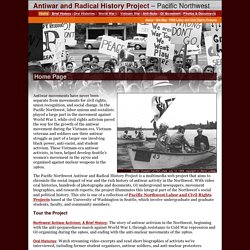
In the Pacific Northwest, labor unions and socialists played a large part in the movement against World War I, while civil rights activism paved the way for the growth of the antiwar movement during the Vietnam era. Vietnam veterans and soldiers saw their antiwar struggle as part of a larger one involving black power, anti-racist, and student activism.
Seattle Civil Rights & Labor History Project. Bracero History Archive. The Bracero Program, which brought millions of Mexican guest workers to the United States, ended more than four decades ago.

Current debates about immigration policy-including discussions about a new guest worker program-have put the program back in the news and made it all the more important to understand this chapter of American history. Yet while top U.S. and Mexican officials re- examine the Bracero Program as a possible model, most Americans know very little about the program, the nation's largest experiment with guest workers. Indeed, until very recently, this important story has been inadequately documented and studied, even by scholars. American Indians of the Pacific Northwest. Home » American Indians of the Pacific Northwest Collection "For 500 generations they flourished until newcomers came... much was lost; much was devalued, but much was also hidden away in the hearts of the dispossessed... ...Their voices insist upon a hearing and the cumulative wisdom of their long residence in this land offers rich insights to those willing to listen.
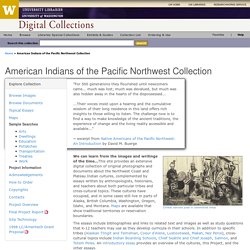
The challenge now is to find a way to make knowledge of the ancient traditions, the experience of change and the living reality accessible and available... We can learn from the images and writings of the time...This site provides an extensive digital collection of original photographs and documents about the Northwest Coast and Plateau Indian cultures, complemented by essays written by anthropologists, historians, and teachers about both particular tribes and cross-cultural topics. Washington Rural Heritage. Shington State Archives - WA Secretary of State. Mainstream Republicans of WashingtonMainstream Republicans of Washington. The Black Past: Remembered and Reclaimed. ED_GUIDE_FINAL. Pacific Northwest History - United States History - Research Guides at University of Washington Tacoma. 1896: The People's Party. The Rise of Populism The People's Party (or Populist Party, as it was widely known) was much younger than the Democratic and Republican Parties, which had been founded before the Civil War.
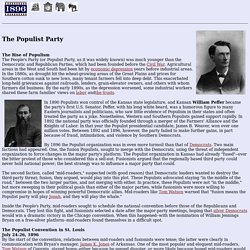
Agricultural areas in the West and South had been hit by economic depression years before industrial areas. In the 1880s, as drought hit the wheat-growing areas of the Great Plains and prices for Southern cotton sunk to new lows, many tenant farmers fell into deep debt. This exacerbated long-held grievances against railroads, lenders, grain-elevator owners, and others with whom farmers did business. By the early 1890s, as the depression worsened, some industrial workers shared these farm families' views on labor andthe trusts. Library of Congress Home. Idaho Historical Society. Idaho Yesterdays. Official Washington State Visitors' Guide. Daily Life In Colonial New England. The first houses in New England were simple wooden huts.
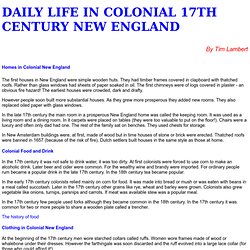
They had timber frames covered in clapboard with thatched roofs. Rather than glass windows had sheets of paper soaked in oil. The first chimneys were of logs covered in plaster - an obvious fire hazard! The earliest houses were crowded, dark and drafty. However people soon built more substantial houses.
In the late 17th century the main room in a prosperous New England home was called the keeping room. In New Amsterdam buildings were, at first, made of wood but in time houses of stone or brick were erected. Colonial Food and Drink In the 17th century it was not safe to drink water, it was too dirty. In the early 17th century colonists relied mainly on corn for food. Northwest History. Washington State Heritage Center.